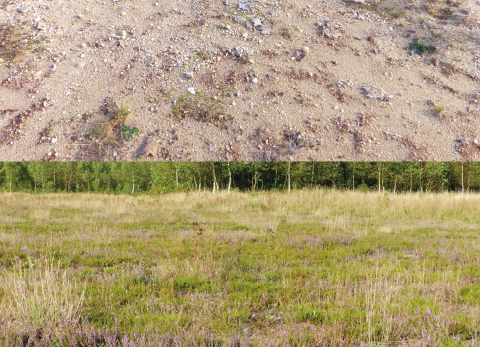Soil inoculation works!

Soil inoculation works!
Degraded ecosystems can be restored to health by inoculating them with natural soil, reports a NIOO paper published in Nature Plants this week. The study also shows that inoculation with different kinds of soil steers recovery towards the donor system. Meaning that intensively farmed land can be directed to become either a species-rich grassland or heathland depending on where the donated soil comes from. First author Jasper Wubs: ‘This finding could help to rewild landscapes that have deteriorated after decades of farming.’
Restoring ex-farmland proves difficult because years of intensive production promotes competitive weeds and disrupts the soil community. Previous studies have shown that transplanting healthy soil to the ex-farmland helps it recover. However, Jasper Wubs and colleagues are the first to show that injecting small amounts of healthy soil biota not only helps restore the land, but that recovery can be directed towards different kinds of ecosystems. ‘Of course, seeds of plants were also present in the donor soil. But our study shows that it is in fact the soil organisms, such as bacteria, fungi and roundworms, that determine the direction of ecosystem restoration,’ explains Wubs.
Thin layer
They removed the top layer of soil from parts of a 160-hectare field that had been farmed for nearly 60 years, and then applied a thin (<1 cm) layer of soil inoculum from grassland or heathland to different areas. Not decades but only six years later, they observed that the treated areas had responded differently, with the inoculated sites acquiring plants associated with grassland or heathland. Furthermore, they found that the plots had been colonized by the characteristic soil invertebrates, microbes and fungi of each kind of ecosystem.
This study confirms the idea of soil inoculation in real ecosystems and at a scale that is relevant for restoration practise. It also shows for the first time that the community of soil organisms is actually in the driver’s seat when it comes to determining the course of ecosystem development. This is similar, for instance, to the use of faecal transplants to restore disrupted gut-microbiomes in humans.
Rewilding Europe
Among scientists, farmers and nature managers there is rapidly growing interest in the role of the soil microbiome, also in the field of ecosystem restoration. Wubs: ‘The EU aims to restore 15% of its degraded ecosystems by 2020 and within the Netherlands and in Europe numerous projects are now starting to use donor soil to speed up and improve restoration, to rewild our landscapes.’
__________________________________________________________________________
More information:
Researcher Jasper Wubs, Department of Terrestrische Ecologie NIOO-KNAW, tel. +31-6-41723213 / +31-317-473580, j.wubs@nioo.knaw.nl, Twitter: @JasperWubs
Project leader Martijn Bezemer, Department of Terrestrische Ecologie NIOO-KNAW, tel. +31-317-473607/+31-6-19177330, m.bezemer@nioo.knaw.nl
Science information officer Froukje Rienks, NIOO-KNAW, tel. +31-6-10487481, f.rienks@nioo.knaw.nl
Photographs & movie: Photographs can be used, mentioning the photographer (J. Wubs/NIOO-KNAW). The short moview explains the soil inoculation experiment at the Reijerscamp area.
Paper: Soil inoculation steers restoration of terrestrial ecosystem. Jasper Wubs, Wim van der Putten, Machiel Bosch & Martijn Bezemer, Nature Plants, Advance Online Publication 11 juli 2016 17.00 uur. www.nature.com/articles/nplants2016107
Some news articles on this paper:
